Optimized Configuration of Multi-Source Measurement Devices Based on Distributed Principles
Abstract
1. Introduction
- The proposed allocation method of measuring equipment is a centralized solution with high model complexity and low efficiency;
- The data types and observability of the model of multi-type measurement data in the actual distribution network are ignored.
2. Grid Optimization Partitioning Methods
2.1. Equivalent Electrical Distance Based on Sensitivity
2.2. Principle of PMU Optimization Allocation Based on Optimal Partitioning
3. Optimization Configuration of Multi-Source Measurement Devices for Power Grid Considering Observability
3.1. Observability
- The node where the measurement device is configured and the nodes connected to it are observable;
- When the observable zero-injection node has only one connected node whose observability is unknown, the connected node is observable;
- When all connected nodes of a ZIB node with unknown observability are observable, the zero-injection node is also observable.
3.2. Consider the Optimal Configuration of Zero-Injection Nodes
- When lNMR ≤ 1, each node only relies on 1 or less than 1 metrology device, and the system has no additional redundancy; when this metrology device fails, the viewability of the network will be affected, and therefore, the system lacks sufficient reliability and fault tolerance.
- When lNMR = 1–3, each node is covered by 2 or 3 measurement devices; the system has some redundancy, and when this measurement device fails, the state of the node can still be observed by other measurement devices.
- When lNMR > 3, each node is covered by 3 or more measurement devices, which is usually adopted in very critical systems to ensure that normal observation and control can be maintained even after the failure of multiple measurement devices.
- Excessive redundancy refers to a very high NMR, which can greatly improve the fault tolerance of the system but tends to bring greater cost and complexity, and is therefore not common in engineering.
4. Example Analysis
4.1. Overview of the Algorithms
4.2. Example Results
4.3. Algorithmic Comparison
5. Conclusions
Author Contributions
Funding
Data Availability Statement
Acknowledgments
Conflicts of Interest
References
- Tian, S.; Li, K.; Wei, S.; Fu, Y.; Li, Z.; Liu, S. Security situation awareness approach for distribution network based on synchronous phasor measurement unit. Proc. CSEE 2021, 41, 617–631. (In Chinese) [Google Scholar]
- Liu, Z.; Wang, C.; Li, P.; Yu, H.; Yu, L.; Li, P. State estimation of distribution networks based on multi-source measurement data and its applications. Proc. CSEE 2021, 41, 2605–2614. (In Chinese) [Google Scholar]
- Huang, M.Y.; Wei, Z.N.; Lin, Y.Z. Forecasting-aided state estimation based on deep learning for hybrid AC/DC distribution systems. Appl. Energy 2022, 306, 118119. [Google Scholar] [CrossRef]
- Wu, Z.; Xu, J.; Yu, X.; Hu, Q.; Dou, X.; Gu, W. Review on state estimation technique of active distribution network. Autom. Electr. Power Syst. 2017, 41, 182–191. (In Chinese) [Google Scholar]
- Shafiullah, M.; Rana, M.J.; Alam, M.S.; Uddin, M.A. Optimal placement of Phasor Measurement Units for transmission grid observability. In Proceedings of the 2016 International Conference on Innovations in Science, Engineering and Technology (ICISET), Dhaka, Bangladesh, 28–29 October 2016; pp. 1–4. [Google Scholar]
- Shafiullah, M.; Abido, M.A.; Hossain, M.I.; Mantawy, A.H. An Improved OPP Problem Formulation for Distribution Grid Observability. Energies 2018, 11, 3069. [Google Scholar] [CrossRef]
- Luo, S.Z. Multi-objective optimal configuration of PMUs based on probabilistic observability of nodes. Guangdong Electr. Power 2023, 36, 39–46. [Google Scholar]
- Yuan, H.; Li, G.; Long, T.; Hou, Z.; Zhang, H.; Bie, Z. Power system reliability assessment taking into account state estimation and sizability. Grid Technol. 2019, 43, 4274–4283. [Google Scholar]
- Muscas, C.; Pau, M.; Pegoraro, P.A.; Sulis, S.; Ponci, F.; Monti, A. Multiarea distribution system state estimation. IEEE Trans. Instrum. Meas. 2015, 64, 1140–1148. [Google Scholar] [CrossRef]
- Liu, M.; Zhou, S.X.; Deng, Y.M.; He, G.Y.; Chen, X.Q. An area-decoupled state estimation method for distribution systems. Autom. Electr. Power Syst. 2005, 29, 79–83. [Google Scholar]
- Liu, K.; Sheng, W.; He, K.; Meng, X.L.; Tang, W.; Ma, J. Distributed state estimation of complex active distribution networks based on Lagrangian relaxation technique. Power Syst. Prot. Control. 2017, 45, 125–132. [Google Scholar]
- Lopatka, P.; Salvini, S.; Nusrat, N.; De-Alvaro, L.; Wallom, D. Performance study of distributed state estimation algorithms on the HiPerDNO HPC platform. In Proceedings of the 47th International Universities Power Engineering Conference (UPEC), Uxbridge, UK, 4–7 September 2012; pp. 1–6. [Google Scholar]
- Tong, J.; Shen, C.; Xiang, B.; Yan, W. A two-stage state estimation method considering grid partitioning. Electr. Appl. 2012, 31, 54–58. (In Chinese) [Google Scholar]
- Du, D.; Li, X.; Li, W.; Chen, R.; Fei, M.; Wu, L. ADMM-based distributed state estimation of smart grid under data deception and denial of service attacks. IEEE Trans. Syst. Man Cybern. Syst. 2019, 49, 1698–1711. [Google Scholar] [CrossRef]
- Mohammadi, M.B.; Hooshmand, R.A.; Fesharaki, F.H. A new approach for optimal placement of PMUs and their required communication infrastructure in order to minimize the cost of the WAMS. IEEE Trans. Smart Grid 2015, 7, 84–93. [Google Scholar] [CrossRef]
- Xu, B.; Abur, A. Observability analysis and measurement placement for systems with PMUSIC. In Proceedings of the IEEE PES Power Systems Conference and Exposition (PSCE), New York, NY, USA, 10–13 October 2004; Volume 2, pp. 943–946. [Google Scholar]
- Koochi, M.; Dehghanian, P.; Esmaeili, S. PMU Placement with Channel Limitation for Faulty Line Detection in Transmission Systems. IEEE Trans. Power Deliv. 2020, 35, 819–827. [Google Scholar] [CrossRef]
- Xi, Y.; Yu, L.; Jiang, W.H.; Chen, B.; Zhou, B.; Liang, B.; Zhang, J.X. Optimal allocation of multi-stage PMUs based on modified hierarchical analysis. Guangdong Electr. Power 2022, 35, 87–93. (In Chinese) [Google Scholar]
- Hu, M.F. Research on High Resistance Fault Detection Method of Distribution Network Based on Limited Synchronous Measurement Data. Master‘s thesis, Shandong University of Technology, Zibo, China, 2022. (In Chinese). [Google Scholar]
- Vedik, B.; Chandel, A.K. Optimal PMU Placement for Power System Observability Using Taguchi Binary Bat Algorithm. Measurement 2017, 95, 8–20. [Google Scholar]
- Siddique, N.I.; Rana, J.; Shafiullah, M.; Mekhilef, S.; Pota, H. Automating distribution networks: Backtracking search algorithm for efficient and cost-effective fault management. Expert Syst. Appl. 2024, 247, 123275. [Google Scholar] [CrossRef]
- Shafiullah, M.; Hossain, M.I.; Abido, M.A.; Abdel-Fattah, T.; Mantawy, A.H. A modified optimal PMU placement problem formulation considering channel limits under various contingencies. Measurement 2019, 135, 875–885. [Google Scholar] [CrossRef]
- Girvan, M.; Newman, M.E. Community structure in social and biological networks. Proc. Natl. Acad. Sci. USA 2002, 99, 7821–7826. [Google Scholar] [CrossRef]
- Baran, M.E.; Wu, F.F. Network reconfiguration in distribution systems for loss reduction and load balancing. IEEE Trans. Power Deliv. 1989, 4, 1401–1407. [Google Scholar] [CrossRef]
- Abdelsalam, H.A.; Abdelaziz, A.Y.; Osama, R.A.; Salem, R.H. Impact of distribution system reconfiguration on optimal placement of phasor measurement units. In Proceedings of the 2014 Clemson University Power Systems Conference, Clemson, SC, USA, 11–14 March 2014; IEEE: Piscataway, NJ, USA, 2014; pp. 1–6. [Google Scholar]
- Kong, X.Y.; Wang, Y.T.; Yuan, X.X.; Yu, L. Optimal PMU configuration based on customized genetic algorithm considering multiple topological viewability of distribution network. Power Autom. Equip. 2020, 40, 66–72. (In Chinese) [Google Scholar]


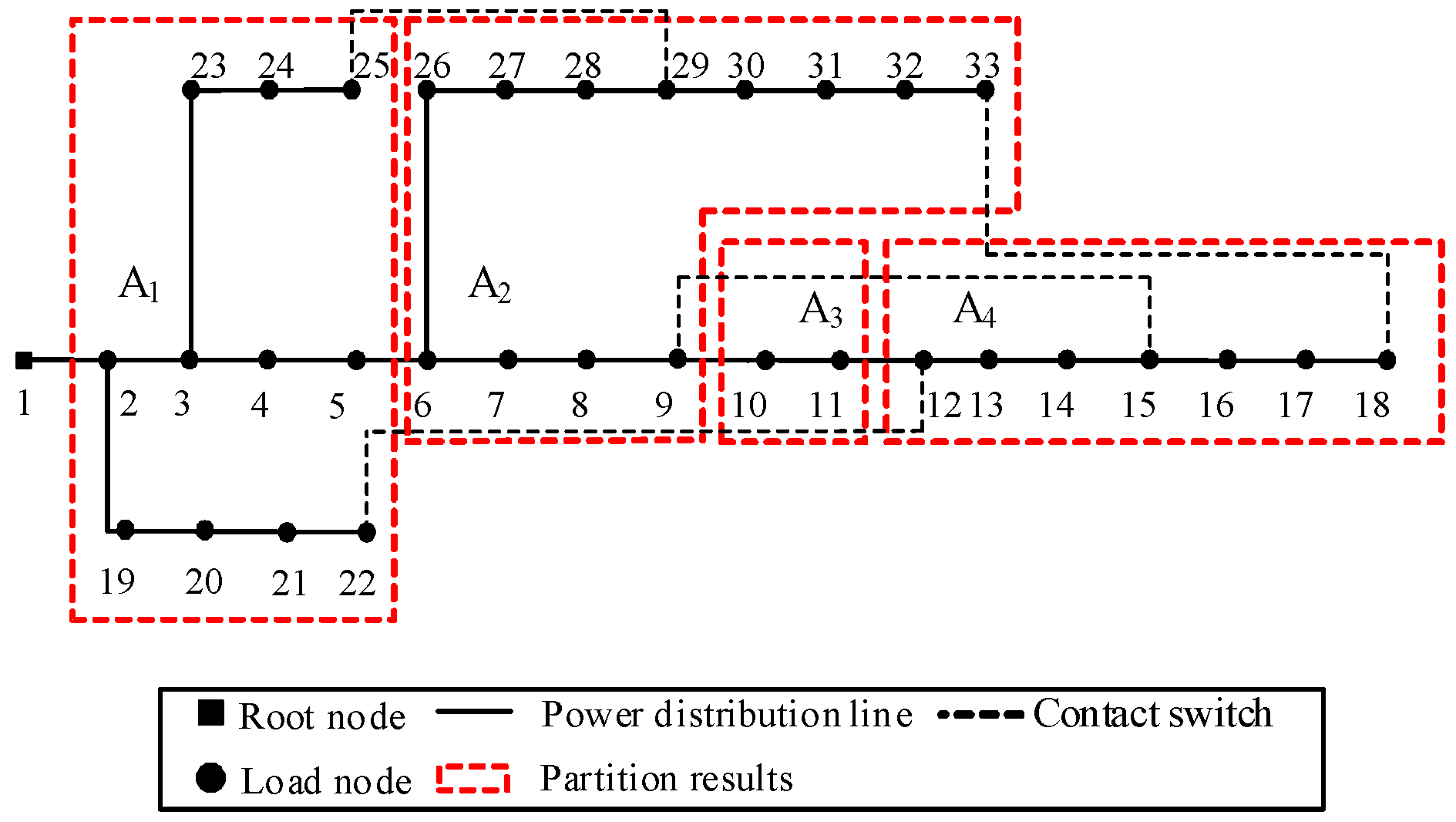
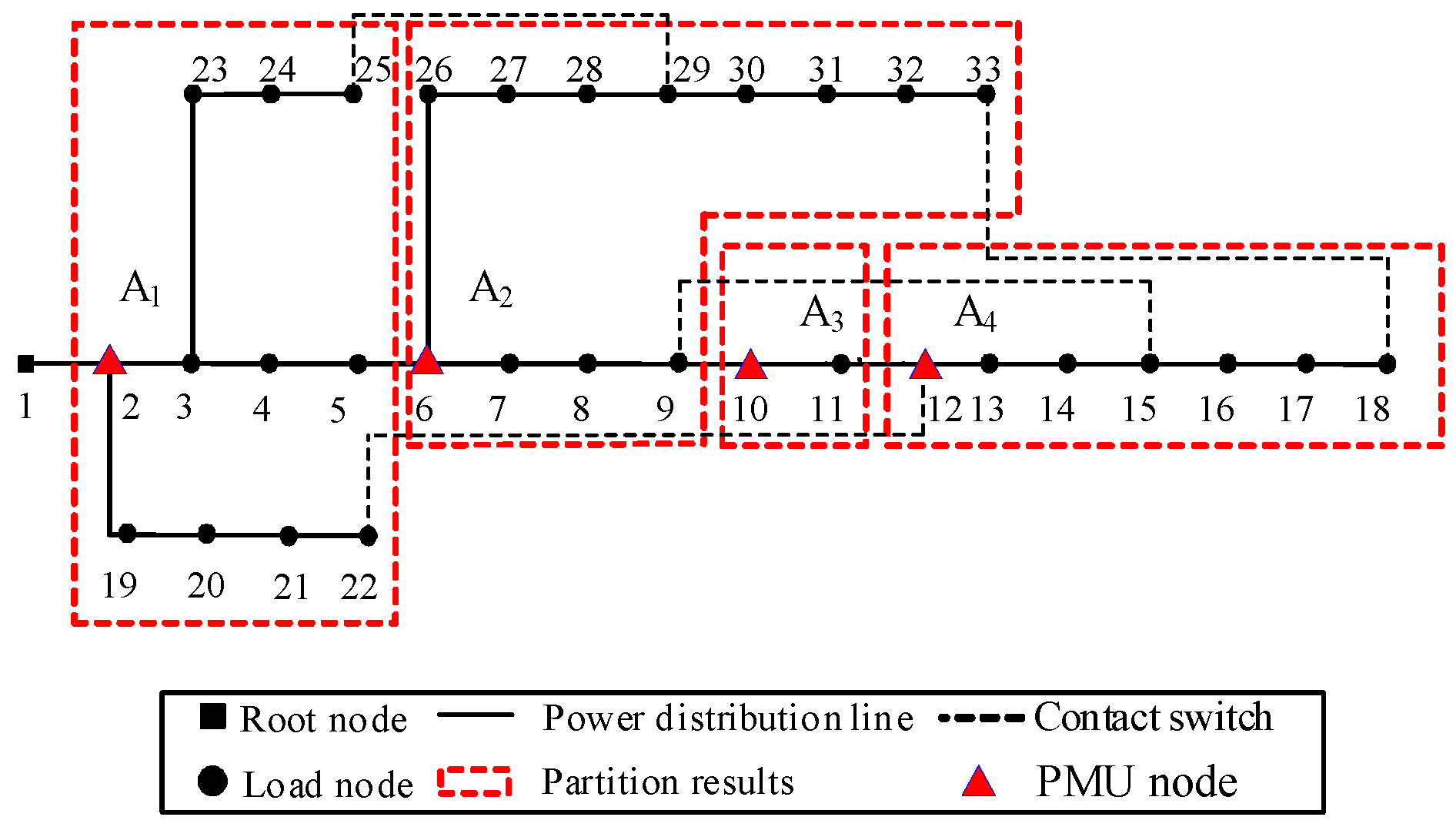
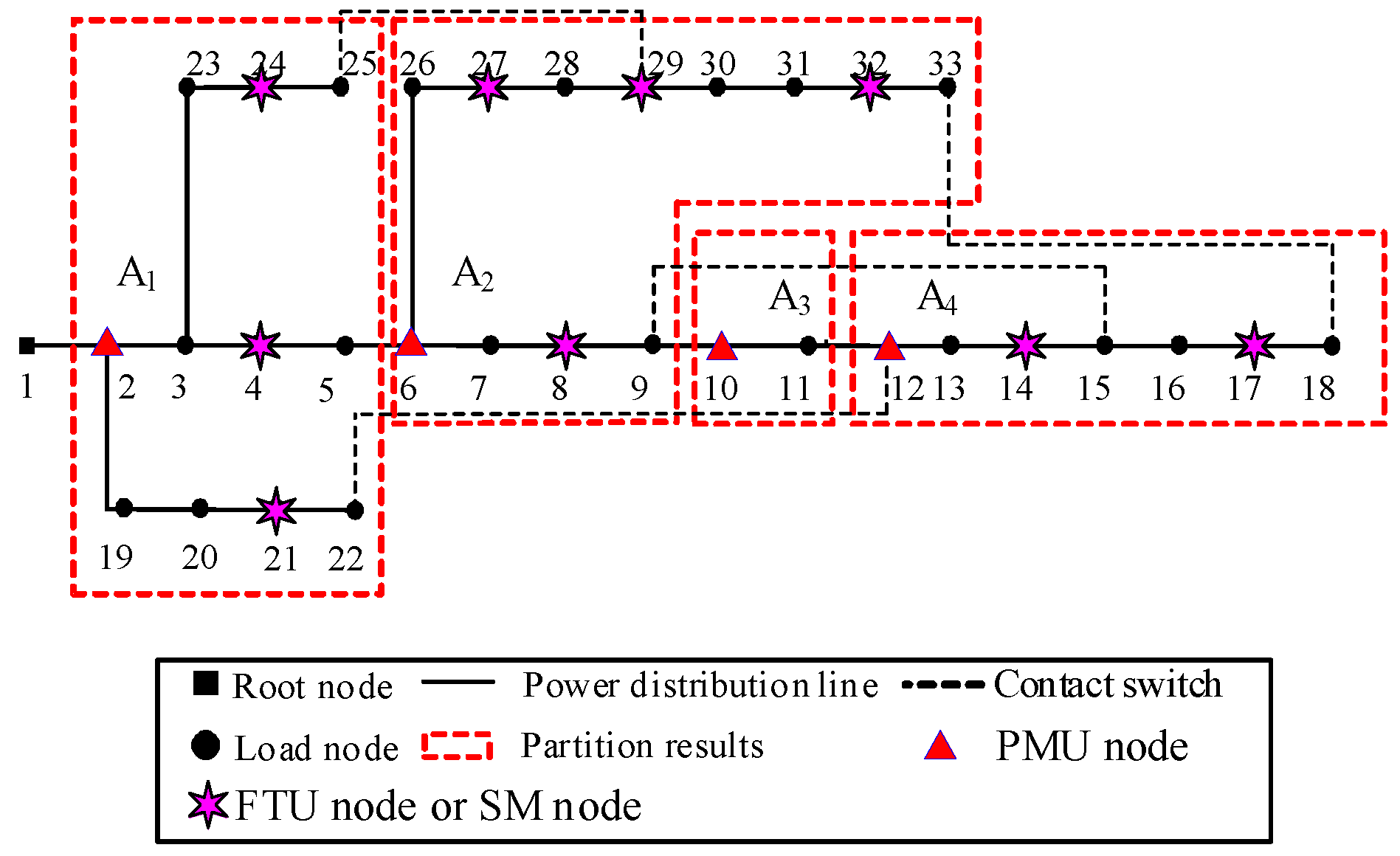
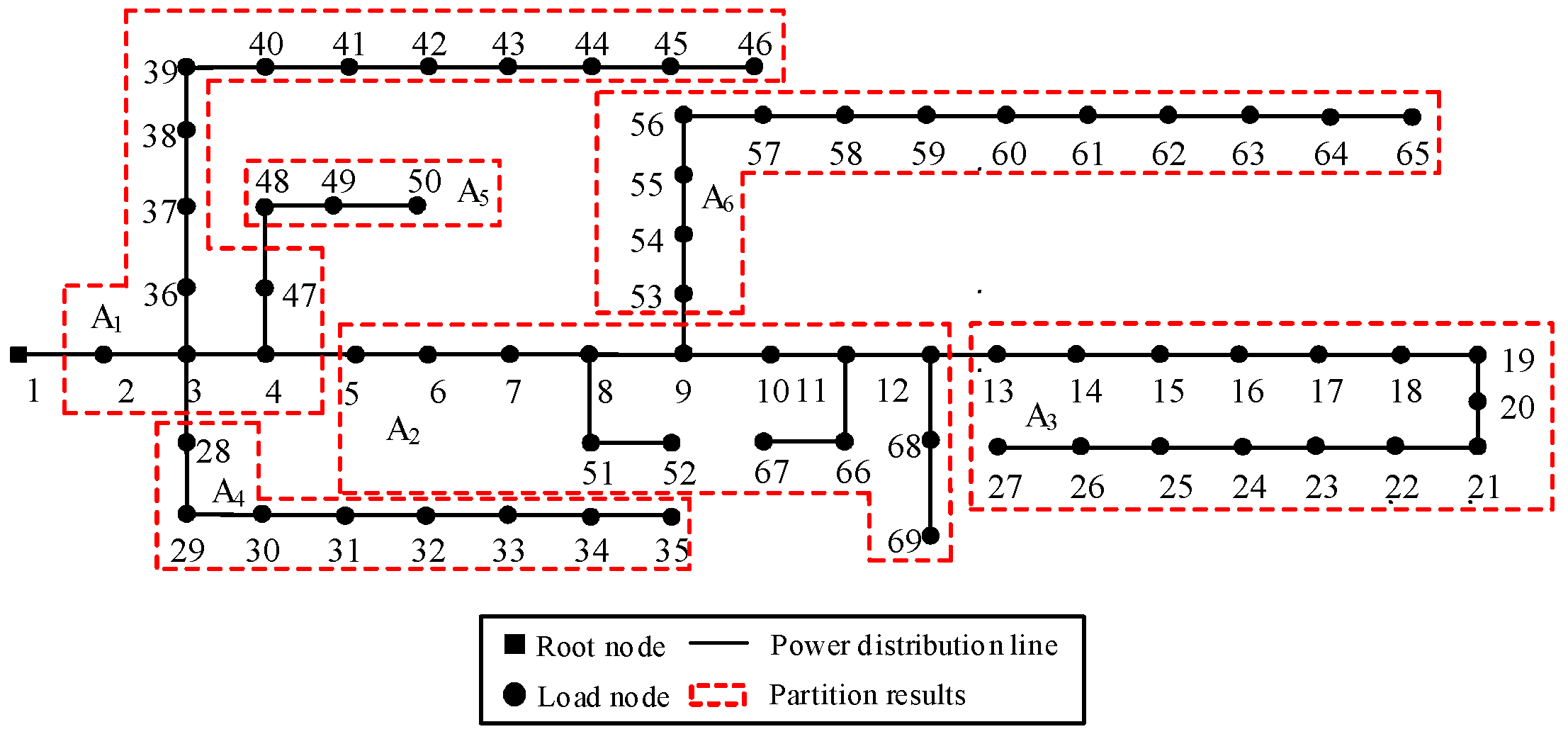
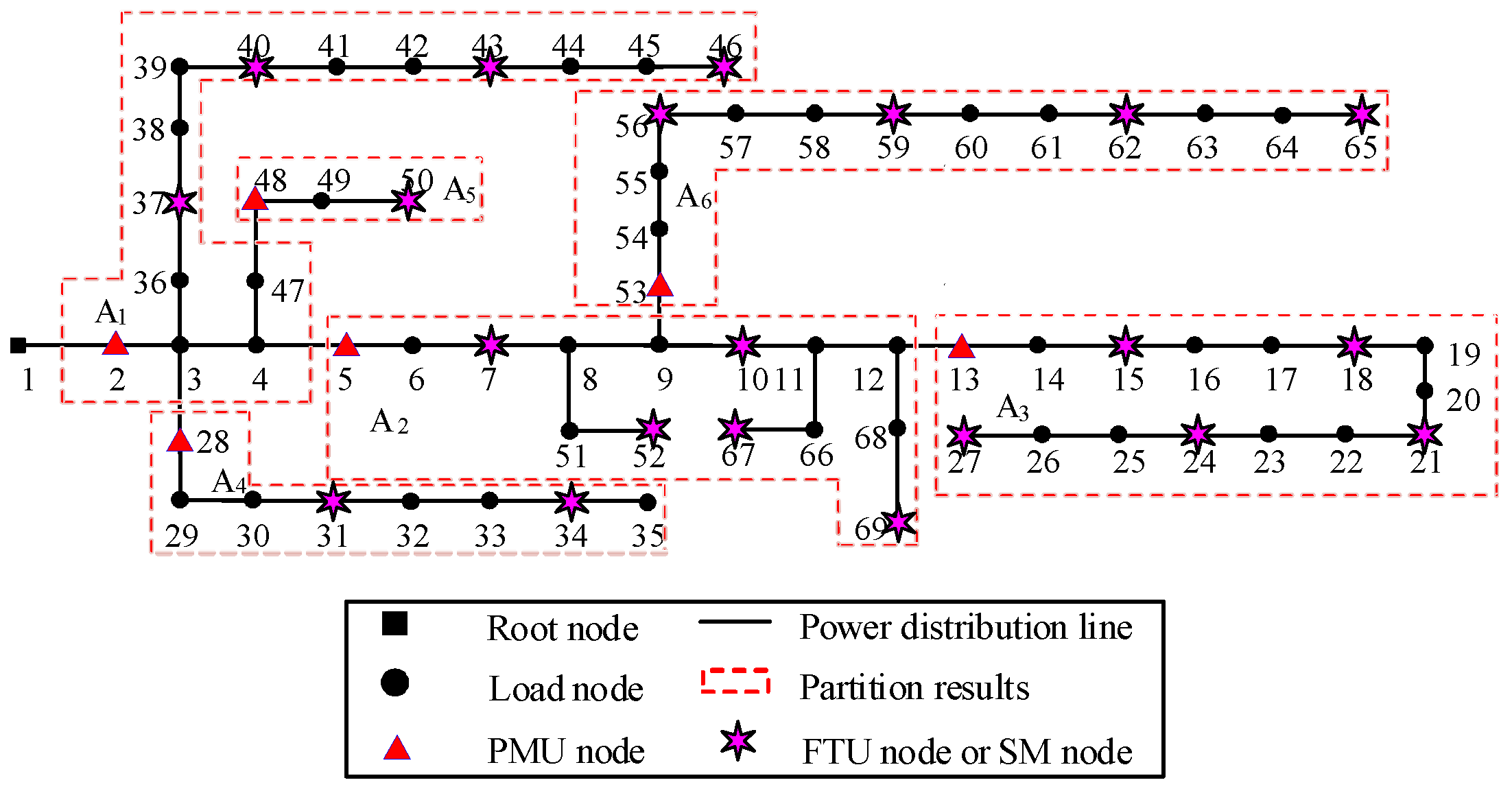
| Allocated Area | Node |
|---|---|
| A1 | 2, 3, 4, 5, 19, 20, 21, 22, 23, 24, 25 |
| A2 | 6, 7, 8, 9, 26, 27, 28, 29, 30, 31, 32, 33 |
| A3 | 10, 11 |
| A4 | 12, 13, 14, 15, 16, 17, 18 |
| Allocated Area | FTU or FI Mounted Nodes |
|---|---|
| A1 | 4, 21, 24 |
| A2 | 8, 27, 29, 32 |
| A3 | / |
| A4 | 14, 17 |
| Allocated Area | Node |
|---|---|
| A1 | 2, 3, 4, 36, 37, 38, 39, 40, 41, 42, 43, 44, 45, 46 |
| A2 | 5, 6, 7, 8, 9, 10, 11, 12, 51, 52, 66, 67, 68, 69 |
| A3 | 13, 14, 15, 16, 17, 18, 19, 20, 21, 22, 23, 24, 25, 26, 27 |
| A4 | 28, 29, 30, 31, 32, 33, 34, 35 |
| A5 | 48, 49, 50 |
| A6 | 53, 54, 55, 56, 57, 58, 59, 60, 61, 62, 63, 64, 65 |
| Methodologies | The Methodology Proposed in This Paper | Literature [21] Methods | Literature [22] Methods |
|---|---|---|---|
| Number of PMU configurations | 4 | 14 | 11 |
| PMU Configuration Node | 2, 6, 10, 12 | 2, 4, 5, 8, 11, 13, 15, 17, 21, 23, 24, 27, 29, 32 | 2, 6, 9, 11, 14, 17, 20, 24, 27, 30, 32 |
| Is the topology sizable | Yes | Yes | Yes |
| Number of remaining measurement equipment configurations | 9 | / | / |
| Remaining Measurement Equipment Configuration Nodes | 4, 8, 14, 17, 21, 24, 27, 29, 32 | / | / |
| lNMR | 3 | 4.72 | 4.43 |
| Requirements | $49,000 | $140,000 | $110,000 |
Disclaimer/Publisher’s Note: The statements, opinions and data contained in all publications are solely those of the individual author(s) and contributor(s) and not of MDPI and/or the editor(s). MDPI and/or the editor(s) disclaim responsibility for any injury to people or property resulting from any ideas, methods, instructions or products referred to in the content. |
© 2025 by the authors. Licensee MDPI, Basel, Switzerland. This article is an open access article distributed under the terms and conditions of the Creative Commons Attribution (CC BY) license (https://creativecommons.org/licenses/by/4.0/).
Share and Cite
Xu, Y.; Zhang, J.; Zhao, J.; Zhang, X.; Ge, J. Optimized Configuration of Multi-Source Measurement Devices Based on Distributed Principles. Energies 2025, 18, 1149. https://doi.org/10.3390/en18051149
Xu Y, Zhang J, Zhao J, Zhang X, Ge J. Optimized Configuration of Multi-Source Measurement Devices Based on Distributed Principles. Energies. 2025; 18(5):1149. https://doi.org/10.3390/en18051149
Chicago/Turabian StyleXu, Yuhao, Jiaqi Zhang, Jing Zhao, Xiaoyu Zhang, and Jinming Ge. 2025. "Optimized Configuration of Multi-Source Measurement Devices Based on Distributed Principles" Energies 18, no. 5: 1149. https://doi.org/10.3390/en18051149
APA StyleXu, Y., Zhang, J., Zhao, J., Zhang, X., & Ge, J. (2025). Optimized Configuration of Multi-Source Measurement Devices Based on Distributed Principles. Energies, 18(5), 1149. https://doi.org/10.3390/en18051149






